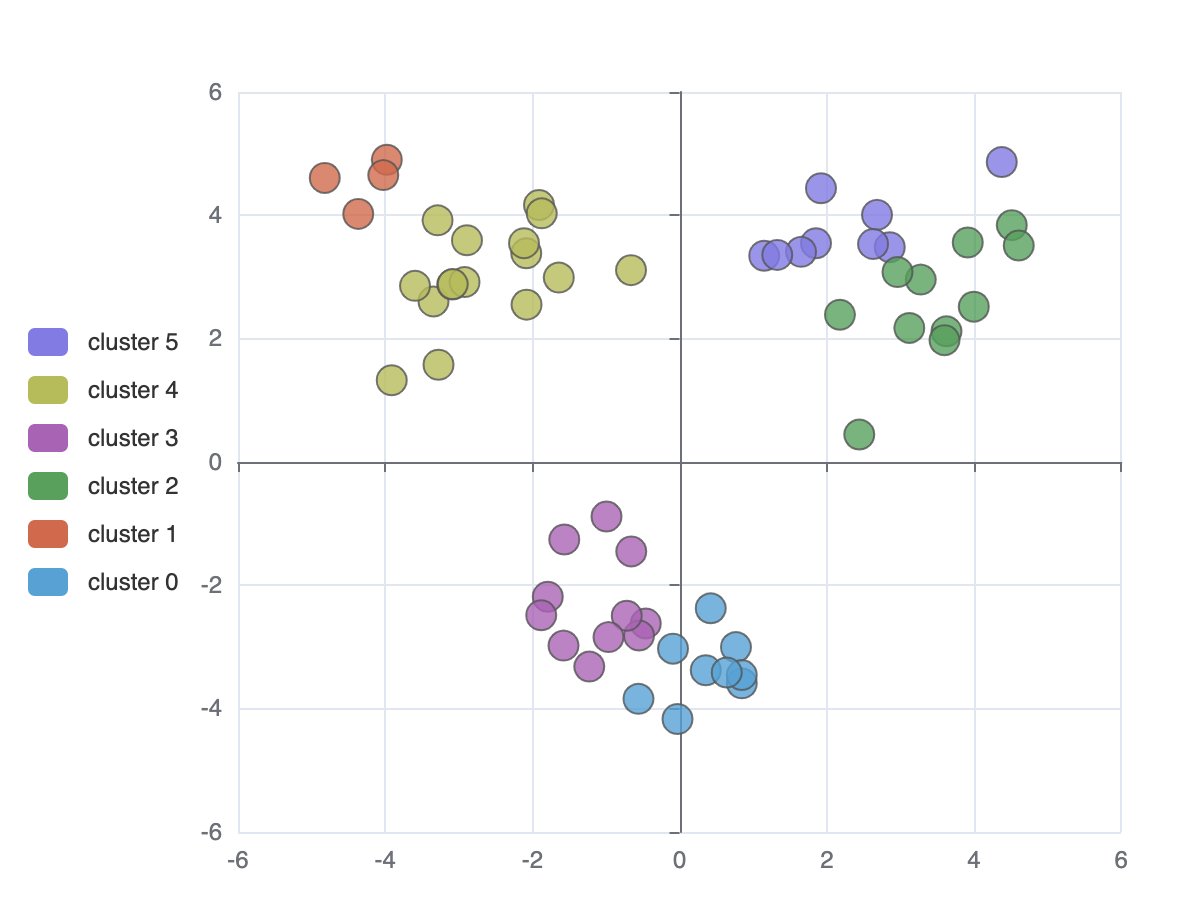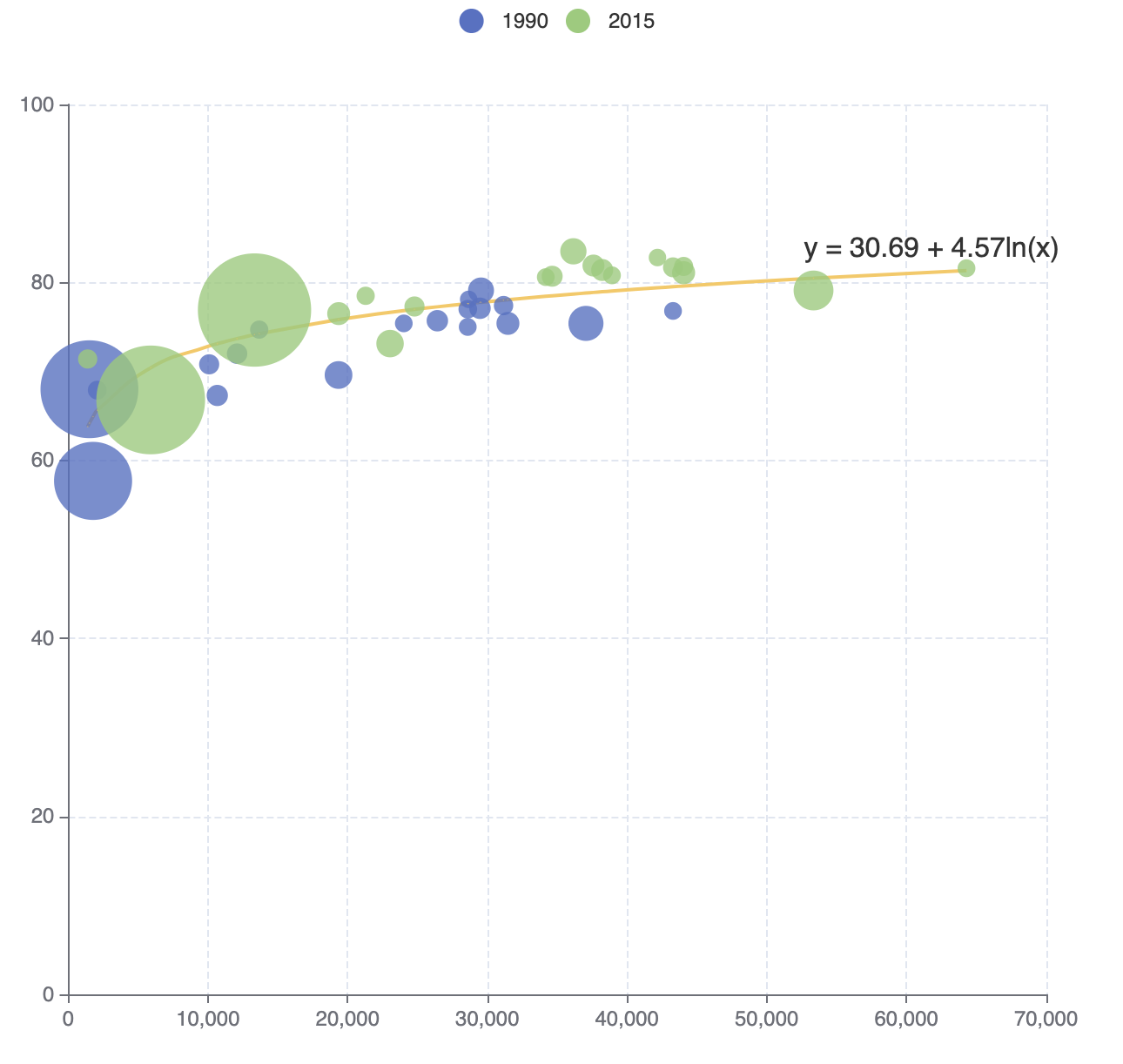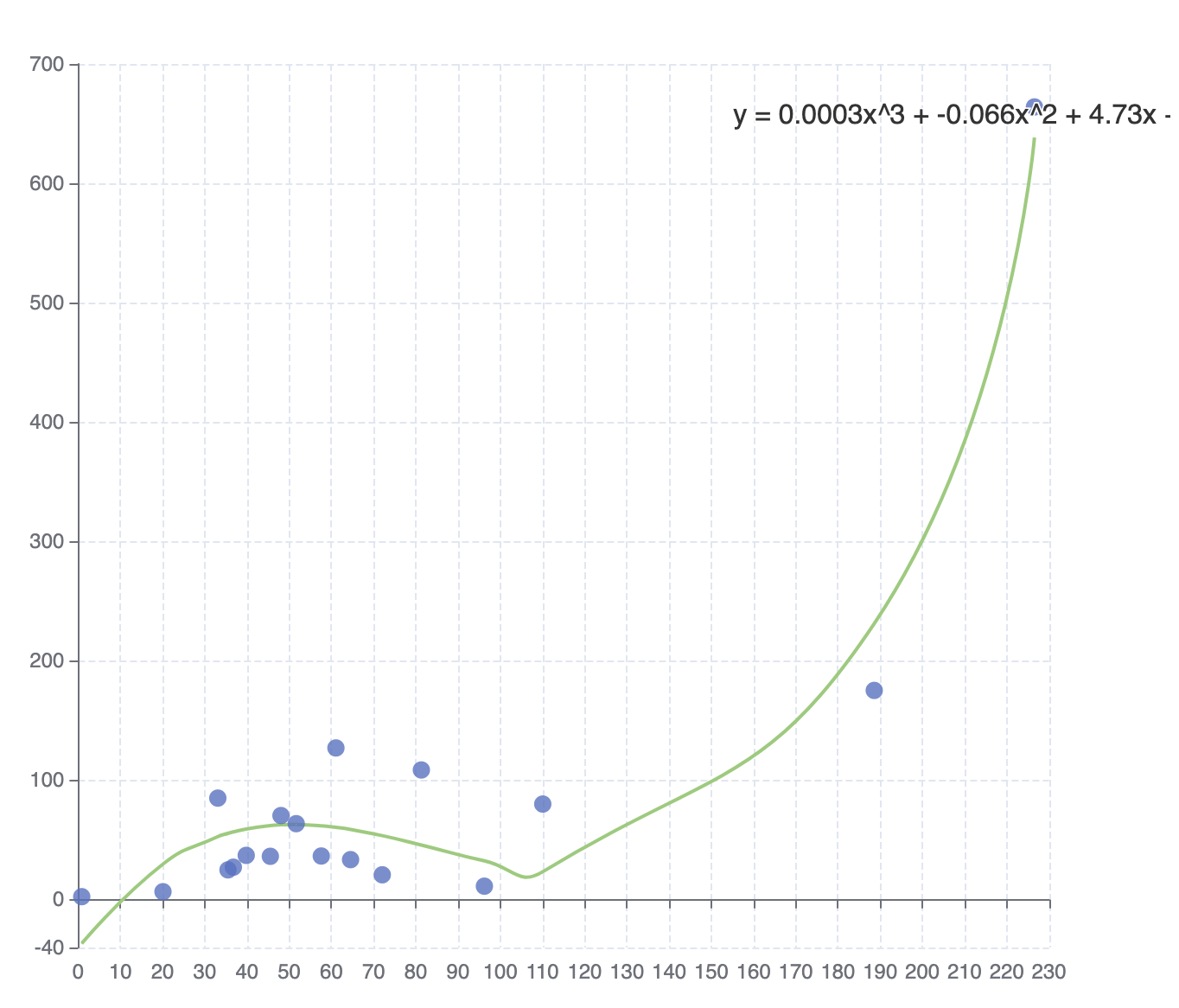echarts-stat-fix v1.1.2
ecStat
A statistical and data mining tool for ECharts. You can use it to analyze data and then visualize the results with ECharts, or just use it to process data.
It works both in node.js and in the browser.
Read this in other languages: English, 简体中文.
Installing
If you use npm, you can install it with:
npm install echarts-statOtherwise, download this tool from dist directory:
<script src='./dist/ecStat.js'></script>
<script>
var result = ecStat.clustering.hierarchicalKMeans(data, clusterNumber, false);
</script>API Reference
Histogram
A histogram is a graphical representation of the distribution of numerical data. It is an estimate of the probability distribution of a quantitative variable. It is a kind of bar graph. To construct a histogram, the first step is to "bin" the range of values - that is, divide the entire range of values into a series of intervals - and then count how many original sample values fall into each interval. The bins are usually specified as consecutive, non-overlapping intervals of a variable. Here the bins(intervals) must be adjacent, and are of equal size.
Syntax
var bins = ecStat.histogram(data, binMethod);Parameter
data-Array<number>. Data samples of numbers.```js var data = [8.6, 8.8, 10.5, 10.7, 10.8, 11.0, ... ]; ```binMethod-string. There are four methods to calculate the number of bin, which aresquareRoot,scott,freedmanDiaconis, andsturges. Of course, there is no "best" number of bin, and different bin size can reveal different feature of data.* `squareRoot` - This is the default method, which is also used by Excel histogram. Returns the number of bin according to [Square-root choice](https://en.wikipedia.org/wiki/Histogram#Mathematical_definition): ```js var bins = ecStat.histogram(data); ``` * `scott` - Returns the number of bin according to [Scott's normal reference Rule](https://en.wikipedia.org/wiki/Histogram#Mathematical_definition): ```js var bins = ecStat.histogram(data, 'scott'); ``` * `freedmanDiaconis` - Returns the number of bin according to [The Freedman-Diaconis rule](https://en.wikipedia.org/wiki/Histogram#Mathematical_definition): ```js var bins = ecStat.histogram(data, 'freedmanDiaconis'); ``` * `sturges` - Returns the number of bin according to [Sturges' formula](https://en.wikipedia.org/wiki/Histogram#Mathematical_definition): ```js var bins = ecStat.histogram(data, 'sturges'); ```
Return Value
bins-Object. Contain detailed messages of each bin and data used for ECharts to draw the histogram.bins.bins-Array.<Object>. An array of bins, where each bin is an object, containing three attributes:x0-number. The lower bound of the bin (inclusive).x1-number. The upper bound of the bin (exclusive).sample-Array.<number>. Containing the associated elements from the input data.bins.data-Array.<Array.<number>>. Used for bar chart to draw the histogram, each bin data is an array not only containing the mean value ofx0andx1, but also the length ofsample, which is the number of sample values in this bin.bins.customData-Array.<Array<number>>. Used for custom chart to draw the histogram, each custom data is an array not only containing thex0andx1, but also the length ofsample, which is the number of sample values in this bin.
Examples
This example using ECharts custom chart to draw the histogram, which is the best type of chart we recommend.
<script src='https://cdn.bootcss.com/echarts/3.4.0/echarts.js'></script>
<script src='./dist/ecStat.js'></script>
<script>
var bins = ecStat.histogram(data);
var option = {
...
series: [{
type: 'custom',
...
}],
...
}
</script>
Clustering
Clustering can divide the original data set into multiple data clusters with different characteristics. And through ECharts, you can visualize the results of clustering, or visualize the process of clustering.
Syntax
var result = ecStat.clustering.hierarchicalKMeans(data, clusterNumber, stepByStep);Parameter
data-Array.<Array.<number>>. Two-dimensional numeric array, each data point can have more than two numeric attributes in the original data set. In the following example,data[0]is calleddata pointanddata[0][1]is one of the numeric attributes ofdata[0].var data = [ [1, 2, 3, 4, 5], [6, 7, 8, 9, 10], [11, 12, 13, 14, 15], ... ];clusterNumer-number. The number of clusters generated. Note that it has to be greater than 1.stepByStep-boolean. Control whether doing the clustering step by step
Return Value
result-Object. Including the centroids, clusterAssment, and pointsInCluster. For Example:```js result.centroids = [ [-0.460, -2.778], [2.934, 3.128], ... ]; // Indicate which cluster each data point belonging to, and the distance to cluster centroids result.clusterAssment = [ [1, 0.145], [2, 0.680], [0, 1.022], ... ]; // Concrete data point in each cluster result.pointsInCluster = [ [ [0.335, -3.376], [-0.994, -0.884], ... ], ... ]; ```
Examples
You can not only do cluster analysis through this interface, but also use ECharts to visualize the results.
Note: the clustering algorithm can handle multiple numeric attributes, but for the convenience of visualization, two numeric attributes are chosen here as an example.
Directly visualize the final results of clustering
<script src='https://cdn.bootcss.com/echarts/3.4.0/echarts.js'></script>
<script src='./dist/ecStat.js'></script>
<script>
var clusterNumber = 3;
var result = ecStat.clustering.hierarchicalKMeans(data, clusterNumber, false);
</script>
Visualize the process of clustering
<script src='https://cdn.bootcss.com/echarts/3.4.0/echarts.js'></script>
<script src='./dist/ecStat.js'></script>
<script>
var clusterNumber = 6;
var result = ecStat.clustering.hierarchicalKMeans(data, clusterNumber, true);
</script>
Regression
Regression algorithm can according to the value of the dependent and independent variables of the data set, fitting out a curve to reflect their trends. The regression algorithm here only supports two numeric attributes.
Syntax
var myRegression = ecStat.regression(regressionType, data, order);Parameters
regressionType-string. There are four types of regression, whice are'linear','exponential','logarithmic','polynomial'.data-Array.<Array.<number>>. Two-dimensional numeric array, Each data object should have two numeric attributes in the original data set. For Example:```js var data = [ [1, 2], [3, 5], ... ]; ```order-number. The order of polynomial. If you choose other types of regression, you can ignore it.
Return Value
myRegression-Object. Including points, parameter, and expression. For Example:```js myRegression.points = [ [1, 2], [3, 4], ... ]; // This is the parameter of linear regression, for other types, it shoule be a little different myRegression.parameter = { gradient: 1.695, intercept: 3.008 }; myRegression.expression = 'y = 1.7x + 3.01'; ```
Examples
You can not only do regression analysis through this interface, you can also use ECharts to visualize the results.
Linear Regression
<script src='https://cdn.bootcss.com/echarts/3.4.0/echarts.js'></script>
<script src='./dist/ecStat.js'></script>
<script>
var myRegression = ecStat.regression('linear', data);
</script>
Exponential Regression
<script src='https://cdn.bootcss.com/echarts/3.4.0/echarts.js'></script>
<script src='./dist/ecStat.js'></script>
<script>
var myRegression = ecStat.regression('exponential', data);
</script>
Logarithmic Regression
<script src='https://cdn.bootcss.com/echarts/3.4.0/echarts.js'></script>
<script src='./dist/ecStat.js'></script>
<script>
var myRegression = ecStat.regression('logarithmic', data);
</script>
Polynomial Regression
<script src='https://cdn.bootcss.com/echarts/3.4.0/echarts.js'></script>
<script src='./dist/ecStat.js'></script>
<script>
var myRegression = ecStat.regression('polynomial', data, 3);
</script>
Statistics
This interface provides basic summary statistical services.
ecStat.statistics.deviation()
Syntax
var sampleDeviation = ecStat.statistics.deviation(dataList);Parameter
dataList:Array.<number>
Return Value
sampleDeviation:number. Return the deviation of the numeric array dataList. If the dataList is empty or the length less than 2, return 0.
ecStat.statistics.sampleVariance()
Syntax
var varianceValue = ecStat.statistics.sampleVariance(dataList);Parameter
dataList:Array.<number>
Return Value
varianceValue:number. Return the variance of the numeric array dataList. If the dataList is empty or the length less than 2, return 0.
ecStat.statistics.quantile()
Syntax
var quantileValue = ecStat.statistics.quantile(dataList, p);Parameter
dataList:Array.<number>. Sorted array of numbers.p:number. where 0 =< p <= 1. For example, the first quartile at p = 0.25, the seconed quartile at p = 0.5(same as the median), and the third quartile at p = 0.75.
Return Value
quantileValue:number. Return the quantile of the sorted array of numbers. If p <= 0 or the length of dataList less than 2, return the first element of the sorted array dataList; if p >= 1, return the last element of the sorted array dataList; If dataList is empty, return 0.
ecStat.statistics.max()
Syntax
var maxValue = ecStat.statistics.max(dataList);Parameter
dataList:Array.<number>
Return Value
maxValue:number. The maximum value of the dataList.
ecStat.statistics.min()
Syntax
var minValue = ecStat.statistics.min(dataList);Parameter
dataList:Array.<number>
Return Value
minValue:number. The minimum value of the dataList.
ecStat.statistics.mean()
Syntax
var meanValue = ecStat.statistics.mean(dataList);Parameter
dataList:Array.<number>
Return Value
meanValue:number. The average of the dataList.
ecStat.statistics.median()
Syntax
var medianValue = ecStat.statistics.median(dataList);Parameter
dataList:Array.<number>. Sorted array of numbers
Return Value
medianValue:number. The median of the dataList.
ecStat.statistics.sum()
Syntax
var sumValue = ecStat.statistics.sum(dataList);Parameter
dataList:Array.<number>
Return Value
sumValue:number. The sum of the dataList.
6 years ago